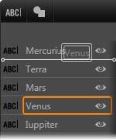Working with the Layer List
The procedures described here are all carried out in the header area of the Layer List.
Selecting layers
Clicking a header in the Layer List has the same effect as selecting the layer in the Player panel preview (and vice versa). The layer name highlights, and the layer’s control frame appears. Multiple selection is also allowed, using the standard Windows mouse and keyboard combinations Shift-click (extend selection), Ctrl-click (toggle selection of one item), and Shift+Ctrl-click (extend selection from last item clicked). See Creating composite titles with layers for information on how to use multiple selections.
Layer names and renaming
When you create a new layer, a default name based on the resource name or file name displays. Since the default names are often not very descriptive of the layer contents, it may be helpful in a title with a number of layers to give them custom names that make it easier to tell at a glance which name goes with which layer.
The name of a new text layer is the same as its default text (“Your text here”). Unless you give the layer a custom name, its default name will continue to match whatever text you type into the layer. Once you do rename a text layer, further changes to the text are no longer reflected in the layer name. The default behavior can be restored by setting a blank name, however.
To rename the primary layer, click its name. An edit field opens with the existing name selected. Type the new name, then press Enter or click outside the edit field to finish.
Reordering layers
The position of a layer in the layer stack can be altered by means of commands on the Layer context submenu, or by keyboard shortcuts such as Ctrl+Plus (Layer > Bring to Front).
The Layer List offers a more direct approach: simply drag the layer header to a new position in the list. This is particularly handy in situations where overlapping layers make mouse selection difficult. As you drag the layer, an insertion line shows where the layer will appear in the list when dropped.
Using multiple selection (see Selecting layers) you can drag several layers at once to a new position.
